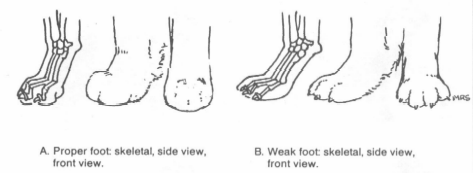NECK, TOPLINE, BODY AND TAIL
The neck is strong and well set on the shoulders and is long enough for proud head carriage. The back is strong, broad, and muscular and is level from just behind the withers to the croup. The chest is full and deep with the brisket reaching at least down to the elbows. Ribs are well sprung, with the anterior third of the rib cage tapered to allow elbow clearance. The flank is deep. The croup is broad and slopes slightly.
Tail set follows the natural line of the croup. The tail is broad at the base and strong. It has no kinks, and the distal bone reaches to the hock. When the dog is standing relaxed, its tail hangs straight or with a slight curve at the end. When the dog is in motion or excited, the tail is carried out, but does not curl over the back.
The neck is muscular and blends into the well laid-back shoulder assembly. The neck of the male is more muscular and thicker than that of the female. A neck too short is generally an indication of poor shoulder placement and puts a Newfoundland out of balance.
From the side, the chest should extend at least to the elbow. From the front, the chest appears deep in brisket (lowest part of the forechest). It is heart shaped, which gives room for the elbows to move and lie properly. The palm of the hand, held horizontally, fits easily between the forelegs.
The prosternum projects beyond the point of shoulder. Rib spring is a factor of substance. Unless the ribs can actually be felt, it is not possible to tell if there is sufficient rib spring, or whether the appearance of substance is due to overweight. The mature dog should be deep in the flank and not excessively tucked up in the belly. The loin must be just long enough to permit suppleness. A dog with too short a loin cannot turn easily without breaking his stride. A dog with too long a loin usually has too much play in the back, thereby losing power of transmission from the hindquarters.
A Newfoundland should not be sway-backed, hollow-backed or soft in the back. He should be neither roached nor camel-backed. The natural coat, or grooming, may make a soft or hollow back appear level, or it can make a level back appear roached or high in rear, so the back must be felt to determine its true conformation and musculature. The croup may also be distorted by coat and should be felt to determine its true slope. A flat croup makes for a high tail set. A too sloping croup throws the hindquarters under the dog and tends to destroy the power that should be developed there. Both conditions spoil the general outline of the dog. The croup should never be higher than the withers.
In motion the tail is usually carried straight out or slightly above the horizontal.

Turned-out, turned-in, splayed, or hare feet are incorrect. Dewclaws that are always found on the front legs need not be removed.
| BACK | CONTENTS | NEXT |